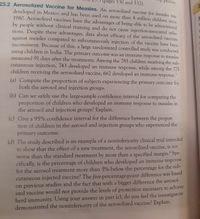
MATLAB: An Introduction with Applications
6th Edition
ISBN: 9781119256830
Author: Amos Gilat
Publisher: John Wiley & Sons Inc
expand_more
expand_more
format_list_bulleted
Question
just need part d answerd

Transcribed Image Text:23.2 Aerosolized Vaccine for Measles. An aerosolized vaccine for measles wwas
(pages 530 and 532).
process
developed in Mexico and has been used on more than 4 million children since
1980, Aerosolized vaccines have the advantages of being able to be administered
by people without clinical training and do not cause injection-associated infec
tions. Despite these advantages, data about efficacy of the aerosolized vaccines
against measles compared to subcutaneously injection of the vaccine have been
inconsistent. Because of this, a large randomized controlled study was conducted
using children in India. The primary outcome was an immune response to measles
measured 91 days after the treatments. Among the 785 children receiving the sub-
cutaneous injection, 743 developed an immune response, while among the 775
children receiving the aerosolized vaccine, 662 developed an immune response.
(a) Compute the proportion of subjects experiencing the primary outcome for
both the aerosol and injection groups.
(b) Can we safely use the large-sample confidence interval for comparing the
proportion of children who developed an immune response to measles in
the aerosol and injection groups? Explain.
(c) Give a 95% confidence interval for the difference between the propor-
tion of children in the aerosol and injection groups who experienced the
primary outcome.
(d) The study described is an example of a noninferiority clinical trial intended
to show that the effect of a new treatment, the aerosolized vaccine, is not
4
worse than the standard treatment by more than a specified margin. Spe-
cifically, is the percentage of children who developed an immune response
for the aerosol treatment more than 5% below the percentage for the sub-
cutaneous injected vaccine? The five-percentage-point difference was based
on previous studies and the fact that with a bigger difference the aerosol-
ized vaccine would not provide the levels of protection necessary to achieve
herd immunity. Using your answer in part (c), do you feel the investigators
demonstrated the noninferiority of the aerosolized vaccine? Explain.
Expert Solution
This question has been solved!
Explore an expertly crafted, step-by-step solution for a thorough understanding of key concepts.
This is a popular solution
Trending nowThis is a popular solution!
Step by stepSolved in 4 steps

Knowledge Booster
Learn more about
Need a deep-dive on the concept behind this application? Look no further. Learn more about this topic, statistics and related others by exploring similar questions and additional content below.Similar questions
arrow_back_ios
arrow_forward_ios
Recommended textbooks for you
 MATLAB: An Introduction with ApplicationsStatisticsISBN:9781119256830Author:Amos GilatPublisher:John Wiley & Sons Inc
MATLAB: An Introduction with ApplicationsStatisticsISBN:9781119256830Author:Amos GilatPublisher:John Wiley & Sons Inc Probability and Statistics for Engineering and th...StatisticsISBN:9781305251809Author:Jay L. DevorePublisher:Cengage Learning
Probability and Statistics for Engineering and th...StatisticsISBN:9781305251809Author:Jay L. DevorePublisher:Cengage Learning Statistics for The Behavioral Sciences (MindTap C...StatisticsISBN:9781305504912Author:Frederick J Gravetter, Larry B. WallnauPublisher:Cengage Learning
Statistics for The Behavioral Sciences (MindTap C...StatisticsISBN:9781305504912Author:Frederick J Gravetter, Larry B. WallnauPublisher:Cengage Learning Elementary Statistics: Picturing the World (7th E...StatisticsISBN:9780134683416Author:Ron Larson, Betsy FarberPublisher:PEARSON
Elementary Statistics: Picturing the World (7th E...StatisticsISBN:9780134683416Author:Ron Larson, Betsy FarberPublisher:PEARSON The Basic Practice of StatisticsStatisticsISBN:9781319042578Author:David S. Moore, William I. Notz, Michael A. FlignerPublisher:W. H. Freeman
The Basic Practice of StatisticsStatisticsISBN:9781319042578Author:David S. Moore, William I. Notz, Michael A. FlignerPublisher:W. H. Freeman Introduction to the Practice of StatisticsStatisticsISBN:9781319013387Author:David S. Moore, George P. McCabe, Bruce A. CraigPublisher:W. H. Freeman
Introduction to the Practice of StatisticsStatisticsISBN:9781319013387Author:David S. Moore, George P. McCabe, Bruce A. CraigPublisher:W. H. Freeman

MATLAB: An Introduction with Applications
Statistics
ISBN:9781119256830
Author:Amos Gilat
Publisher:John Wiley & Sons Inc

Probability and Statistics for Engineering and th...
Statistics
ISBN:9781305251809
Author:Jay L. Devore
Publisher:Cengage Learning

Statistics for The Behavioral Sciences (MindTap C...
Statistics
ISBN:9781305504912
Author:Frederick J Gravetter, Larry B. Wallnau
Publisher:Cengage Learning

Elementary Statistics: Picturing the World (7th E...
Statistics
ISBN:9780134683416
Author:Ron Larson, Betsy Farber
Publisher:PEARSON

The Basic Practice of Statistics
Statistics
ISBN:9781319042578
Author:David S. Moore, William I. Notz, Michael A. Fligner
Publisher:W. H. Freeman

Introduction to the Practice of Statistics
Statistics
ISBN:9781319013387
Author:David S. Moore, George P. McCabe, Bruce A. Craig
Publisher:W. H. Freeman